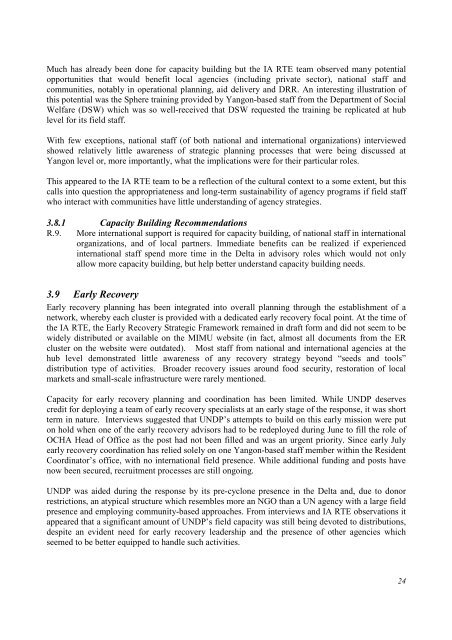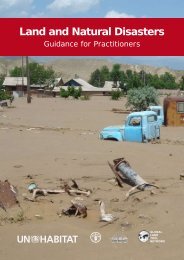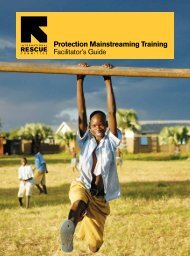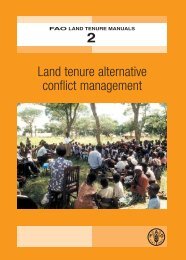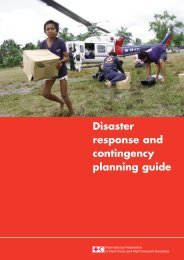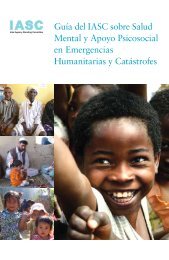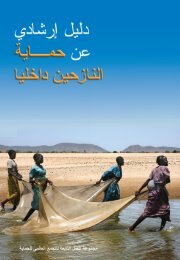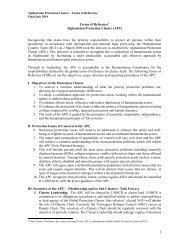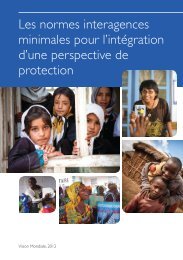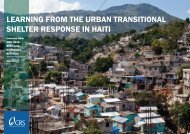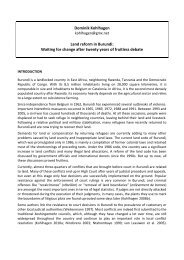Inter-Agency Real Time Evaluation of the Response to Cyclone Nargis
Inter-Agency Real Time Evaluation of the Response to Cyclone Nargis
Inter-Agency Real Time Evaluation of the Response to Cyclone Nargis
Create successful ePaper yourself
Turn your PDF publications into a flip-book with our unique Google optimized e-Paper software.
Much has already been done for capacity building but <strong>the</strong> IA RTE team observed many potentialopportunities that would benefit local agencies (including private sec<strong>to</strong>r), national staff andcommunities, notably in operational planning, aid delivery and DRR. An interesting illustration <strong>of</strong>this potential was <strong>the</strong> Sphere training provided by Yangon-based staff from <strong>the</strong> Department <strong>of</strong> SocialWelfare (DSW) which was so well-received that DSW requested <strong>the</strong> training be replicated at hublevel for its field staff.With few exceptions, national staff (<strong>of</strong> both national and international organizations) interviewedshowed relatively little awareness <strong>of</strong> strategic planning processes that were being discussed atYangon level or, more importantly, what <strong>the</strong> implications were for <strong>the</strong>ir particular roles.This appeared <strong>to</strong> <strong>the</strong> IA RTE team <strong>to</strong> be a reflection <strong>of</strong> <strong>the</strong> cultural context <strong>to</strong> a some extent, but thiscalls in<strong>to</strong> question <strong>the</strong> appropriateness and long-term sustainability <strong>of</strong> agency programs if field staffwho interact with communities have little understanding <strong>of</strong> agency strategies.3.8.1 Capacity Building RecommendationsR.9. More international support is required for capacity building, <strong>of</strong> national staff in internationalorganizations, and <strong>of</strong> local partners. Immediate benefits can be realized if experiencedinternational staff spend more time in <strong>the</strong> Delta in advisory roles which would not onlyallow more capacity building, but help better understand capacity building needs.3.9 Early RecoveryEarly recovery planning has been integrated in<strong>to</strong> overall planning through <strong>the</strong> establishment <strong>of</strong> anetwork, whereby each cluster is provided with a dedicated early recovery focal point. At <strong>the</strong> time <strong>of</strong><strong>the</strong> IA RTE, <strong>the</strong> Early Recovery Strategic Framework remained in draft form and did not seem <strong>to</strong> bewidely distributed or available on <strong>the</strong> MIMU website (in fact, almost all documents from <strong>the</strong> ERcluster on <strong>the</strong> website were outdated). Most staff from national and international agencies at <strong>the</strong>hub level demonstrated little awareness <strong>of</strong> any recovery strategy beyond “seeds and <strong>to</strong>ols”distribution type <strong>of</strong> activities. Broader recovery issues around food security, res<strong>to</strong>ration <strong>of</strong> localmarkets and small-scale infrastructure were rarely mentioned.Capacity for early recovery planning and coordination has been limited. While UNDP deservescredit for deploying a team <strong>of</strong> early recovery specialists at an early stage <strong>of</strong> <strong>the</strong> response, it was shortterm in nature. <strong>Inter</strong>views suggested that UNDP’s attempts <strong>to</strong> build on this early mission were pu<strong>to</strong>n hold when one <strong>of</strong> <strong>the</strong> early recovery advisors had <strong>to</strong> be redeployed during June <strong>to</strong> fill <strong>the</strong> role <strong>of</strong>OCHA Head <strong>of</strong> Office as <strong>the</strong> post had not been filled and was an urgent priority. Since early Julyearly recovery coordination has relied solely on one Yangon-based staff member within <strong>the</strong> ResidentCoordina<strong>to</strong>r’s <strong>of</strong>fice, with no international field presence. While additional funding and posts havenow been secured, recruitment processes are still ongoing.UNDP was aided during <strong>the</strong> response by its pre-cyclone presence in <strong>the</strong> Delta and, due <strong>to</strong> donorrestrictions, an atypical structure which resembles more an NGO than a UN agency with a large fieldpresence and employing community-based approaches. From interviews and IA RTE observations itappeared that a significant amount <strong>of</strong> UNDP’s field capacity was still being devoted <strong>to</strong> distributions,despite an evident need for early recovery leadership and <strong>the</strong> presence <strong>of</strong> o<strong>the</strong>r agencies whichseemed <strong>to</strong> be better equipped <strong>to</strong> handle such activities.24


